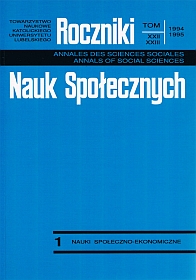Równe prawa, równe szanse? − Z zagadnień równości praw kobiet i mężczyzn
Abstrakt
The paper discusses the problem how is the basic principle binding in democratic societies being realized, what is citizens’ equality and lack of discrimination in view of sex. Despite many declarations contained in the law binding during the communist period there was no real equality between women and men in Poland. The rate of women, despite that they are better educated than men, and despite that their participation in the labour market is very high, was in the communist period and is now very low at executive posts. Their incomes were and are ca by 30% to 40% lower than men’s incomes. The participation of women in the authorities is also very low, and that both in the local authorities, in the Sejm and in the government.
Despite the declaration of equality irrespectively of their sex the Polish legal system contains a series of regulations which introduce inequality between men and women. As an example here we may quote the regulations which define e.g. jobs forbidden to women or allowing only women to take doctor’s leave to take care about the sick child. These regulations are illegitimately called women’s "privileges". In fact they confine the freedom of choice accorded to individuals as regards their job. Parents are also limited in their choice of the person to take care about their child, imposing respective duties on women exclusively.
The inequalities created in the old system are accompanied now by the new ones, connected with the new economic system. Women are burdened with the higher costs of transformation of the economic system, to a greater extent they are concerned with unemployment, their chances on the labour market are limited, and women take less part in the formation of the new economic sphere.
This situation calls for new strategies which would change this state of affairs. It must be many-sided actions; one of their important elements should be the introduction of the laws of equal chances of men and women.
Copyright (c) 1995 Roczniki Nauk Społecznych

Utwór dostępny jest na licencji Creative Commons Uznanie autorstwa – Użycie niekomercyjne – Bez utworów zależnych 4.0 Międzynarodowe.


